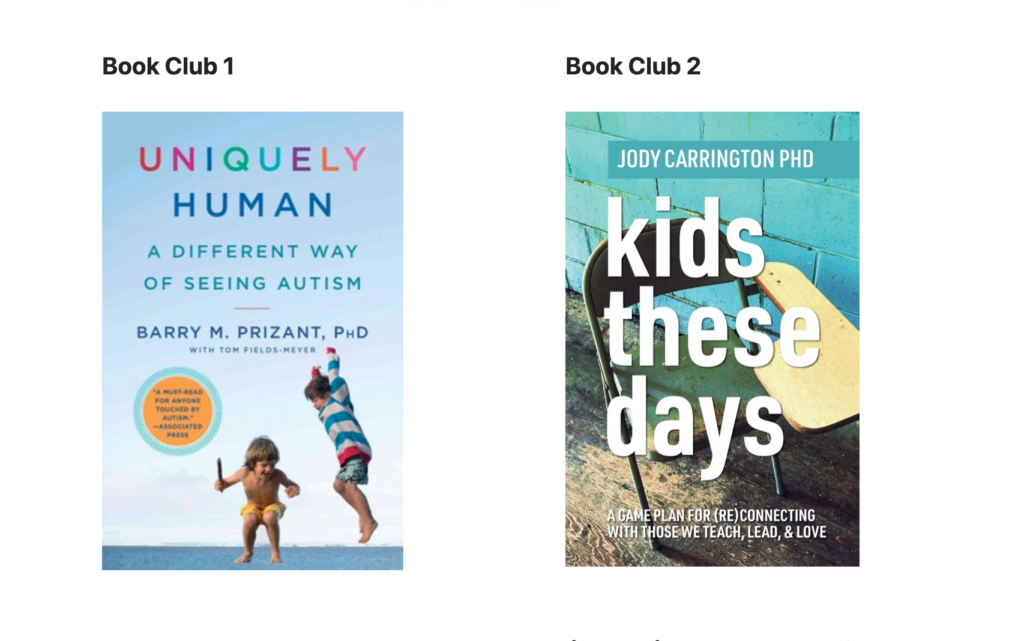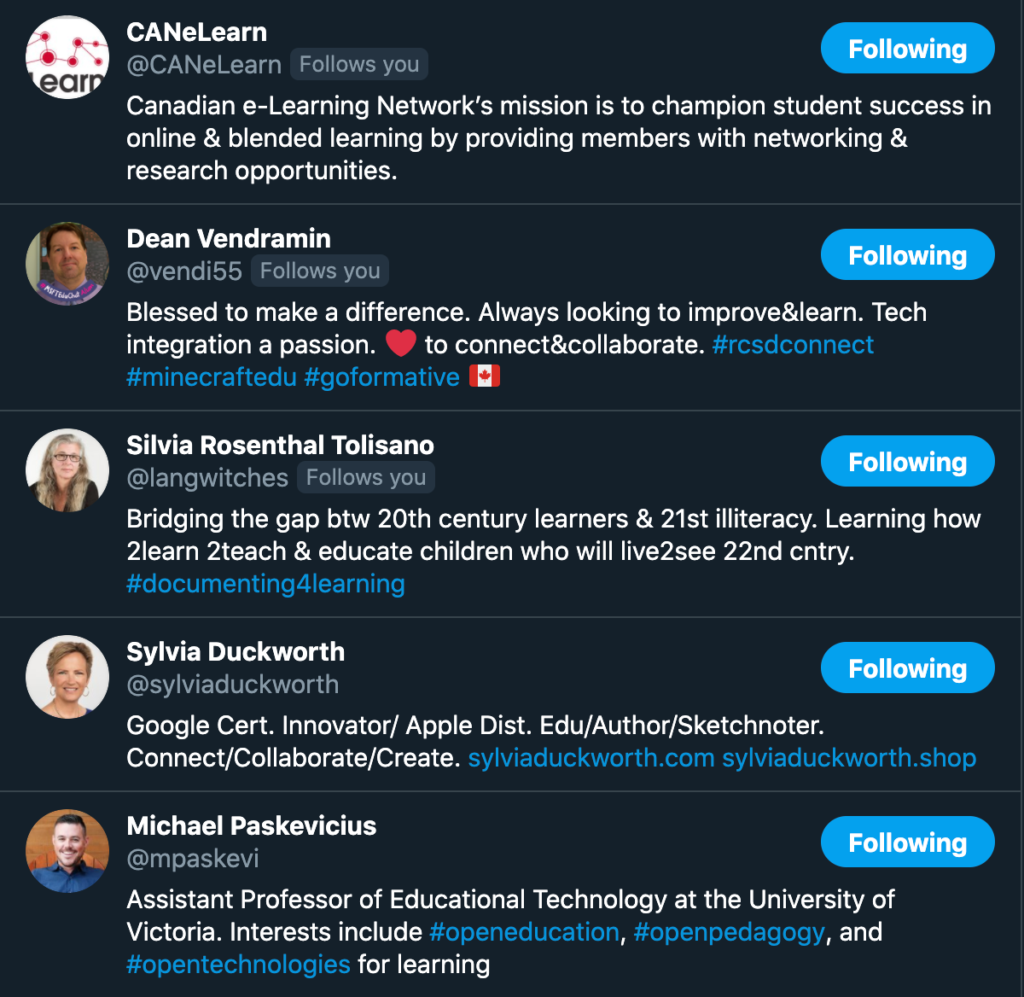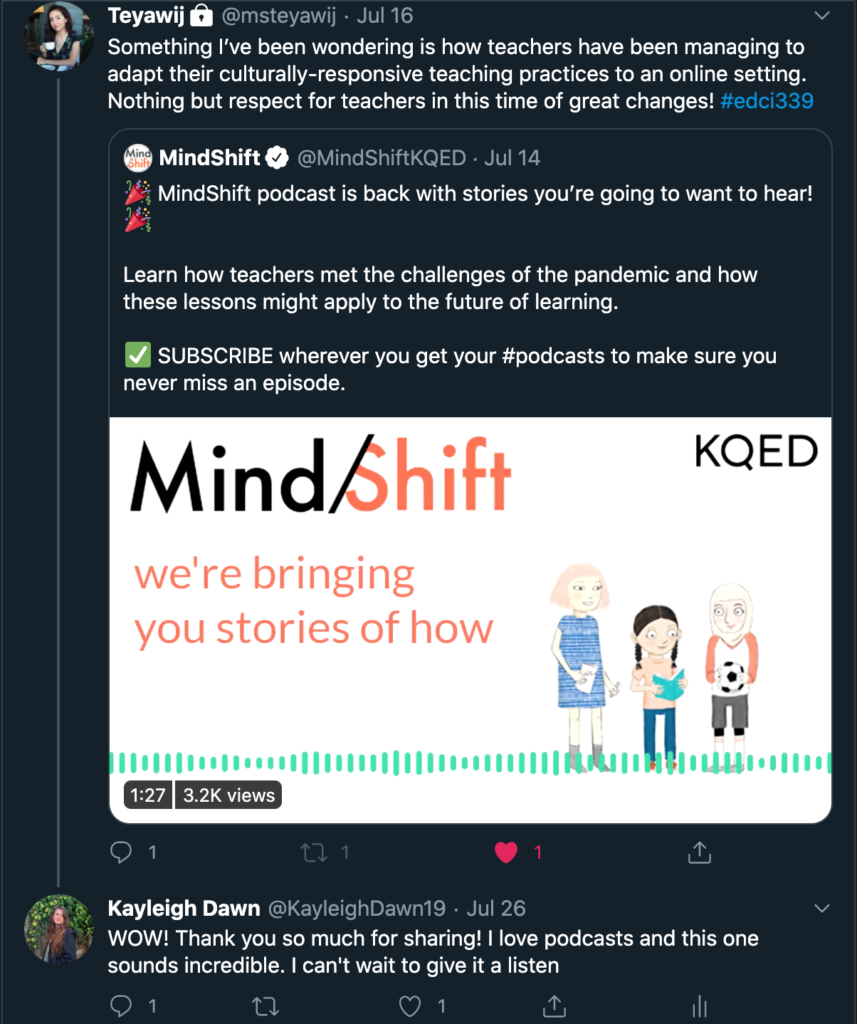Hello, and welcome to my revamped and final blog post for EDCI 339! Below is a GoogleDoc highlighting the changes I made on my Topic 3 Blog post, a mindmap I created to help organize my learning experience, and an audio-recording about how and why I decided to update my Topic 3 Post.
Here are links to my Topic 1 & 2 Blog Posts:
THE HISTORICAL AND THEORETICAL TRENDS IN K-12 ONLINE AND DISTRIBUTED LEARNING
Google Doc: https://docs.google.com/document/d/1D3dqjjhN73fJGx_0QeOPYElx-3RLPPyiEBjsd4UPXg4/edit?usp=sharing
MindMap: https://miro.com/app/board/o9J_ko9Dsrk=/
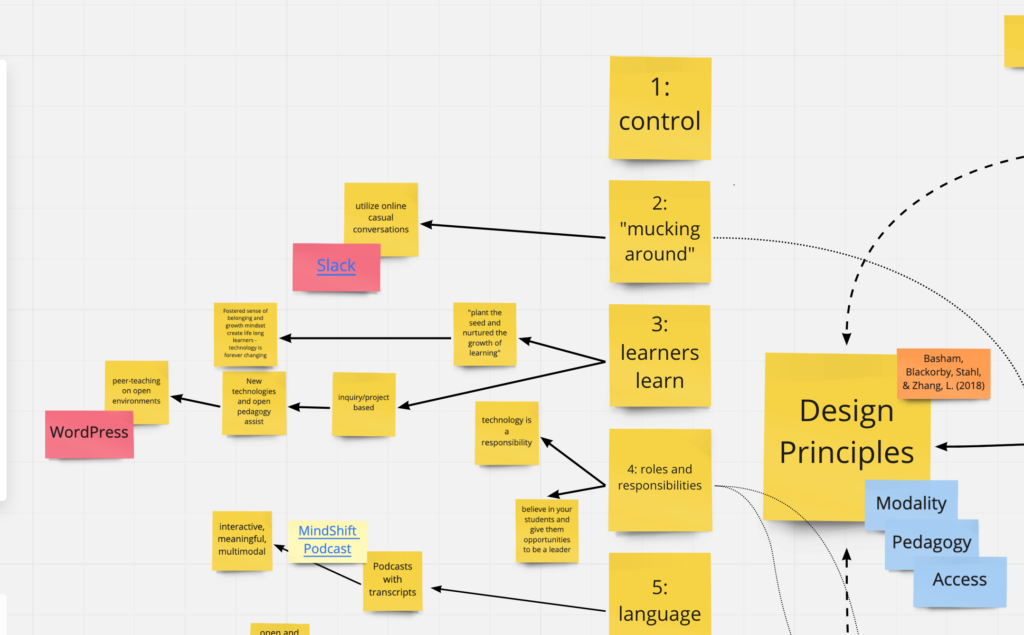
Audio-Clip:
I believe that every student has the right to be and feel valued, respected, and essential, no matter who they are. Every student has a unique set of values and knowledge, and this knowledge can add to both my own and their fellow students’ learning. Over the last few years, I have gained experience adapting lesson plans and projects with diverse learners and utilizing the Universal Design for Learning (UDL) within my lesson plans. EDCI339 has made me incredibly passionate about equity in open and online learning environments, more specifically, for the BIPOC community. Basham, Blackorby, Stahl, & Zhang, L. (2018), so beautifully depict one of the main reasons why UDL is essential in all learning contexts: “Originally formulated as an approach for ensuring the effective inclusion of students with disabilities and diverse learning needs in general education classrooms, UDL has steadily gained traction as a framework for addressing the variability inherent in all learners.” (Bashem et al. 2018). I gained more insight into learner variety by reading “Learner Variability is the Rule, Not the Exception” by Barbara Pape (2018). She depicts the idea that every learner that enters your classroom comes with differing backgrounds, experiences, learning preferences, and motivational drivers. Today’s learners are diverse and variable, and many of the forms of assessment and methods of teaching aren’t practical for everyone. Although online learning provides a multitude of benefits, online learning can be far more difficult for students living in poverty, have disabilities, and ELL’s. For educators to close the gap apparent in online learning contexts, it is essential to look at how technology can be a gateway towards the employment of UDL principles of multiple means of engagement, action and expression, and representation. Online and open learning allows students to develop their sense of mastery, independence, belonging, and inquiry. When paired with UDL principles, online and open learning contexts can be adaptable, accessible, and personalized for various learners.
The more knowledge I gained in online and open learning contexts, the more I have become interested in how disproportionately underrepresented BIPOC are in e-learning programs. Due to lack of funding, training, resources, and research, there are only three e-learning programs in Canada dedicated to First Nations, Métis and Inuit (Barbour, M & Labonte, R., 2018, pg. 606). , Kral, I. & Schwab, R.G. (2012), depicted eight design principles that assist inequity and development of learning spaces:
- Design Principle 1: A space young people control
- Design Principle 2: A space for hanging out and ‘mucking around.’
- Design Principle 3: A space where learners learn
- Design Principle 4: A space to grow into new roles and responsibilities
- Design Principle 5: A space to practice oral and written language
- Design Principle 6: A space to express self and cultural identity through multimodal forms
- Design Principle 7: A space to develop and engage in enterprise
- Design Principle 8: A space to engage with the world
Just as UDL principles assist a variety of learners, the design principles don’t only apply to indigenous groups. When you make an environment more accessible, it allows everyone to feel included and motivated to learn. Below is an infographic that I created to assist my peers, fellow teachers, and my future self in implementing the Design Principles in open and online learning contexts and tools and resources that I learned about throughout the course. There was a multitude of themes that carried throughout the chapter: the deficit mindset assumed by educators and institutions; The Circle of Courage guiding motivation and learning experience; mutual respect; and relevance of existing knowledge and meaningful activity. A deficit mindset is something I become familiar with when taking a webinar in June, “Student Voices Challenging Adult Racism to Create Anti-Racist Schools,” held by The National Association of Black Male Educators. In that webinar, students and teachers discussed how approaching BIPOC students with a deficit perspective lead to a lack of motivation because students begin to believe what teachers assume, that they can achieve what other students can. Design Principle 1 outlines that a space that young people control assists in counteracting such perspectives and motivates students through a sense of autonomy, agency, and independence. Technology has assisted Indigenous communities immensely, as personal hand-held devices allow students the ability to utilize technology that is not locked in a classroom. In EDCI 336, I did a group inquiry project about Technology Assisted Technology, and we created a resource that shares an array of online tools that assist in UDL Checkpoints. Many of the resources provided are free and compatible with handheld devices. https://jessoneducation.opened.ca/wp-content/uploads/sites/945/2019/11/Cream-and-Pink-IT-Manager-Technology-Resume-1.pdf. Open-learning could be an active pathway for BIPOC as it will enable them to have a choice in their learning experience. Technology can also assist students in control over the smallest decisions, which increases confidence and decision-making skills. Marginalized and rural communities must have spaces where they can have access to information and produce knowledge.
In order to connect the 8 Design Principles into actions you can take in your classroom, I created an infographic.
8 Design Principles: Hyperlinked Version
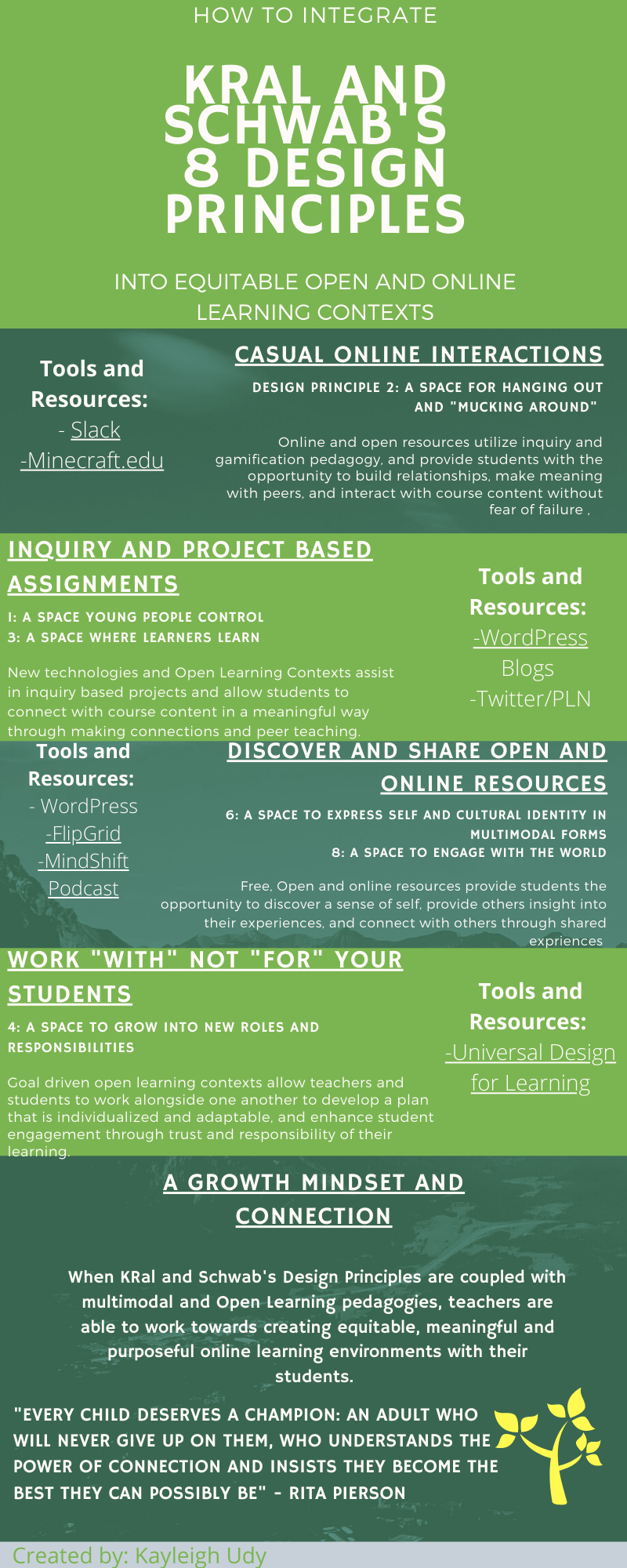
Throughout EDCI 339, I have found unbelievable value in open resources, online learning communities, and open data. When resources such as podcasts, personal learning networks, WordPress, etc., are integrated into both educators’ and students’ learning experiences, they have opportunities to build connections, make meaning, and personalized learning environments. Below is a small list of resources I have compiled that dive into open and online learning environments, where equity, inquiry, accessibility, and adaptability are the core focus.
ONLINE LEARNING COMMUNITIES: Hyperlinked Version
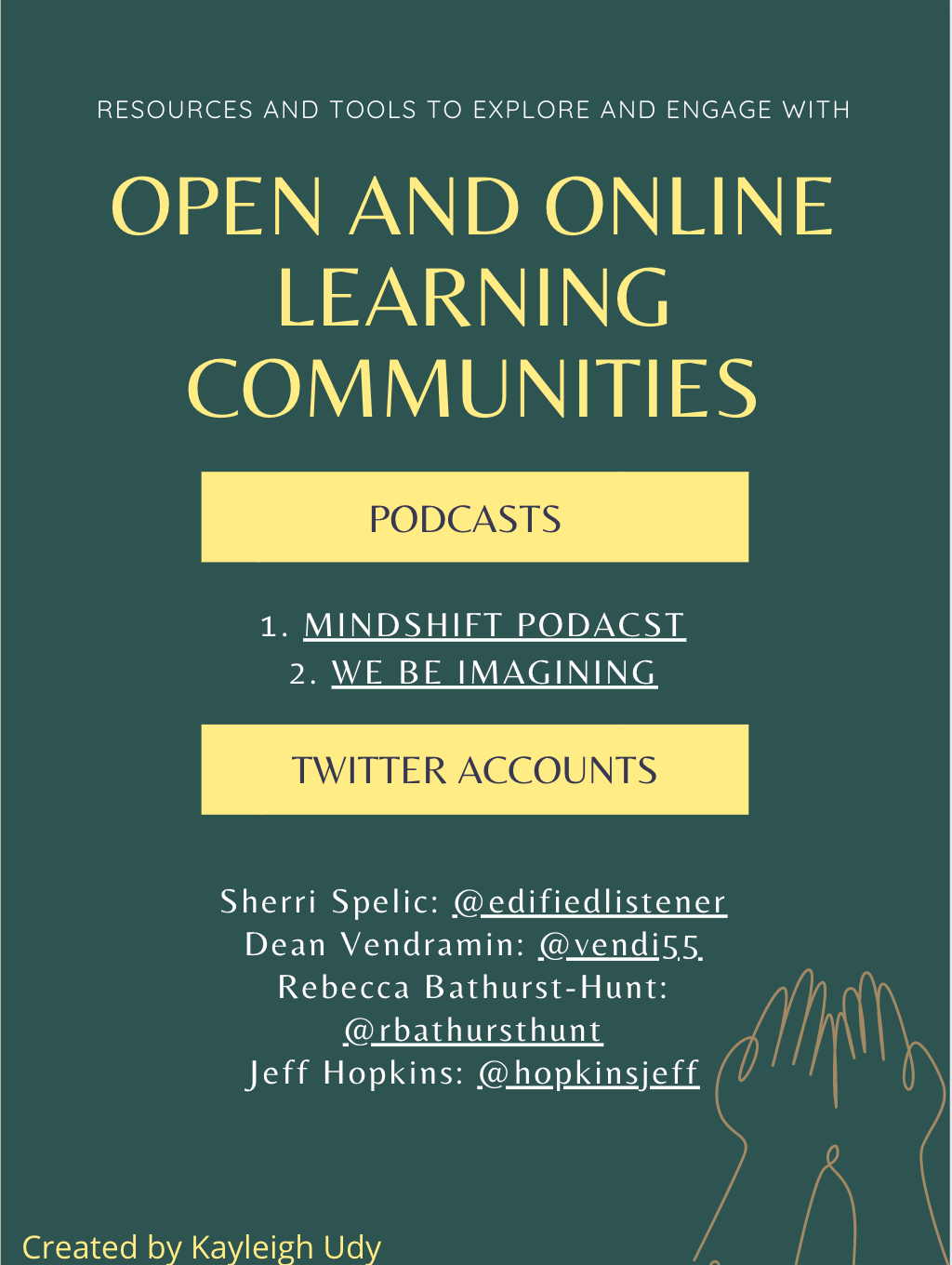
Finally, I created an audio-file describing how I hope to employ the knowledge I have gained throughout the course into my work as an educator. I plan to come back to this post in the future to make updates on resources and tools that I have discovered throughout my learning journey.
References:
Barbour, M & Labonte, R. (2018). An Overview of eLearning Organizations and Practices in Canada. In R. Ferdig & K. Kennedy (Eds.), Handbook of research on K-12 online and blended learning (pp. 600-616). Pittsburgh, PA: Carnegie Mellon University ETC Press.
Pape, B. (2018). Learner Variability is the Rule, Not the Exception. https://digitalpromise.org/wp-content/uploads/2018/06/Learner-Variability-Is-The-Rule.pdf.
Basham, J.D., Blackorby, J., Stahl, S. & Zhang, L. (2018) Universal Design for Learning Because Students are (the) Variable. In R. Ferdig & K. Kennedy (Eds.), Handbook of research on K-12 online and blended learning (pp. 477-507). Pittsburgh, PA: Carnegie Mellon University ETC Press.
Brown, B (2010). The power of vulnerability. Retrieved from
https://www.ted.com/talks/brene_brown_the_power_of_vulnerability
KQED (Producer). (2017, October, 10) How listening to podcasts help students read and learn (Audio podcast) Retrieved from https://open.spotify.com/episode/4idP8nwLX0FlXSNgHNHN0G?si=9-s9Kg85SjqpClYZCII4xg
Kral, I. & Schwab, R.G. (2012). Chapter 4: Design Principles for Indigenous Learning Spaces. Safe Learning Spaces. Youth, Literacy and New Media in Remote Indigenous Australia. ANU Press. http://doi.org/10.22459/LS.08.2012 Retrieved from: http://press-files.anu.edu.au/downloads/press/p197731/pdf/ch041.pdf
Pierson, R (2013). Every kid needs a champion. Retrieved from
https://www.ted.com/talks/rita_pierson_every_kid_needs_a_champion
Reclaiming Youth Network. “The Circle of Courage Philosophy.” 2007.
UDL: The UDL Guidelines. (2017, November 28). Cast.Org. http://udlguidelines.cast.org/
